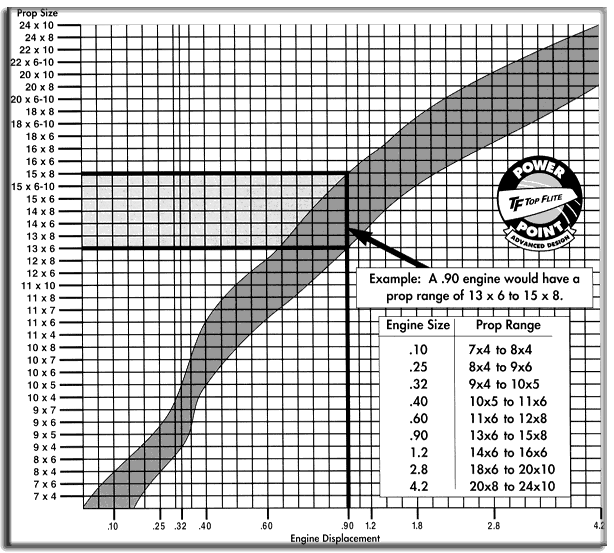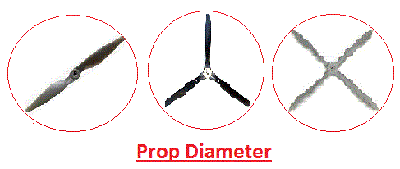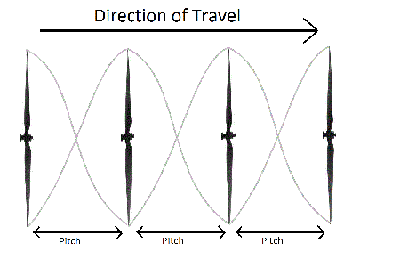Sizing RC Airplane Propellers
Sizing RC airplane propellers may seem intimidating at first, but don’t be afraid to experiment. A common misconception is that the engine/motor size dictates the size of your propeller. But in reality it’s your airplane and flying style that the prop must be sized for.
Don’t get me wrong, it’s very important to stay within this recommended range of the power plant. If the load is too large your engine will not have the power to spin fast enough to get your plane off the ground. Too large of a prop will also cause your engine to overheat in hurry.
The propeller puts a “load” on the engine. If the load is too small your engine will run faster than it’s designed for. If you’re flying electric, the current draw is what you have to worry about. Too large of a propeller load leads to a fried motor, especially in the heat of the summer. Been there and done that a few times. No fun…
Use the Propeller Chart
Use the Top Flight propeller chart below when sizing RC airplane propellers for a glow engine.. From that range you can experiment until you find one that feels just right!

When sizing RC airplane propellers, keep in mind that the Top Flight chart is sized for 2-stroke engines.
Four-stroke engines produce more torque at slower speeds, so they’re use larger propellers.
Your engine literature will tell you what size props are safe to use.
If you’re sizing RC airplane propellers for an electric plane, do yourself a huge favor and pickup up a current meter.
It's likely to pay for itself in a hurry considering
the price of a motor and a possible demolished airplane should a dead-stick
landing have an unhappy ending…
Defining a Propeller
Size

When sizing an RC airplane propeller you have to choose the pitch and diameter.
Although there are variable pitch props available for RC planes, we’ll assume for now that we’re dealing with standard fixed pitch propellers.
For a single blade prop, the diameter is the length of the propeller from one tip to the other. Or if you're dealing with a 3 and 4 bladed propellers, the diameter is simply twice the length of each blade.

The pitch is defined as the distance the propeller would move the airplane forward in one rotation in a “perfect” world. The “twist” of the propeller is what determines the pitch.
Perfect world meaning that the propeller is 100%
efficient and the air does not compress, neither of which is practical in the
real world.
In a nutshell, the “length” and “twist” is what defines the size of an RC propeller. For example, a 11” diameter propl with a 6” pitch is called a 11 X 6 propeller.
How Diameter and
Pitch Affects Flight
Generally speaking, the larger the diameter of the propeller the more thrust will be produced by the engine or motor. The larger the pitch the more speed you will get out of your engine.
Sizing RC airplane propellers is much like shifting t gears in your car. When you shift gears you are changing the ratio of torque and speed. The difference with propellers is that you’re changing the ratio of thrust and speed.
Unlike a car where you can change gears on the go, fixed pitch props used on most RC airplanes can't be changed while in the air. The key is finding the right combination of pitch and diameter that will work well through your entire flight.
Variable pitch propellers for RC planes are available and make for some mind boggling stunts in what is called 4D flying. But for all practical purposes, most of us use fixed pitched props on our RC airplanes.
A small diameter large pitched propeller will move a small volume of air really fast! A large diameter small pitch propeller will move a large volume of air at a slower speed.
Increasing either the pitch or the diameter puts a larger load on the engine. To keep within the safe proper load for a particular motor or engine, you generally change the pitch and diameter together. For example, 9x7, 10x6, and 11x5 propellers would all put a very similar load on the engine.
If you want to change the maximum RPM, then you need to change the load on the engine. Replacing a 11x6 prop with a 10x6 prop, or replacing a 11 X 6 prop with a 11 x 5 prop will decrease the load on the engine and raise the max RPM.
Changing from a 10 x 6 to 10 x 7 prop, or changing from a 10 x 6 prop to a 11 x 6 prop will increase the load and lower the max RPM.
Can't Size Prop on
Engine/Motor Size Alone
I’ll mention this again because it’s important.
When sizing RC airplane propellers, you are choosing the propeller based on how you want the airplane to fly.
This really has nothing to do with the engine or motor other than the fact that you must stay within the recommended window of props to prevent damage.
Two different RC airplanes using the same size engine or motor could very well be using two different size props.
For example, if you have an airplane with low drag designed for speed then you will want more pitch. If you have a slow airplane with a lot of drag, such this bi-plane here, you’ll want more diameter (thrust) and less pitch (speed).
Sizing RC airplane propellers really is a trial and error process until you find that best size for you airplane and flying style.
Pick up several propellers within the recommended range. If your airplane seems too sluggish when taking off and accelerating then change to a lower pitch larger diameter prop.
If your plane has plenty of pep and you want to make it go faster, then change to a larger pitch smaller diameter propeller.
More on RC Airplane Props Below
- Fundamentals of Model Airplane Propellers
- Types of RC Props
- 3 and 4 Bladed Props
- Construction of RC Props
- Balancing the Propeller
Home > Model Airplane Propellers > Sizing RC Airplane Propellers